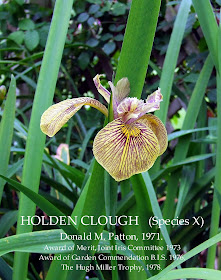This iris has a confused past with its name which was changed to Sunset because apparently the name 'Ochracea-Coerulea' was considered 'Clumsy'. I covered this issue in the post 'The Iris Re-Christened SUNSET', originally published in 'The Garden' in 1922. As you can see below Lee Bonnewitz discription of the iris in his 1926 catalogue was also confusing.
Ochracea-Coerulea is without doubt a stylish iris that one could expect to see at Giverny, the Gardens of Claude Monet or possibly it is in the Iris collection at Sissinghurst Castle Gardens. These irises are once again becoming available for purchase from commercial growers, and I'm sure they will create a renewed interest in classic irises and be wildly popular with gardeners who appreciate real class. The amazing photo taken by Nathalie Faivre in the Gardens at Parc Floral de Paris.
The Garden, June 17, 1922.
New and Rare Plants.
Iris ochracea-coerulea. A very delightful Iris. The standards are copper coloured and the falls have brown reticulations with a yellow base. The blade is bluish, shading to copper. Award of Merit. This variety was raised by Mr. Denis of Balaruc-les-Bains and shown by Mr. W. R. Dykes.
The Garden, June 24, 1922.
Among the June Irises.
The richly if sombrely tinted Sunset, also illustrated, also marks a notable advance. It received a well deserved award of merit at the recent Iris Show under the clumsy name I. ochracea coerulea. Very free flowering and an excellent grower, its good form the picture will attest. It is, we understand, to be distributed this autumn by Messrs. G. G. Whitelegg and Co.
Millet et Fils, Bourg-la-Reine, Seine, France. Catalogue 1922
OCHRACEA-COERULEA (Denis) très tàrdif, jaune citron et mauve lilacè, violet cobée, coloris original.
The Gardener's Chronicle 1922.
Awards of Merit
Iris Ochracea-Coerulea. — In this charming variety the standards are bright copper colour and the semi-horizontal falls are yellow based, with brown reticulations, while the blade is dull blue, shading to copper. Raised bv M. Denis, of Balaruc les-Bains. Shown by W. R. Dykes, Esq.
 |
| The Gardener's Chronicle 1922 |
Cayeux & Le Clerc, Quai de la Mègisserie, 8, Paris. Catalog 1923
Ochracea-Coerulea (Denis 1919).S.old gold colour. F. of the same tone tinted blue-lilac and cobea violet. Pretty and distinct colour. Vigorous plant, very free and late flowering. Has been also named 'Sunset'. This iris has obtained a Certificate of Merit S.N.H.F. when shown by us on May 1922.
Bulletin of the American Iris Society, January 1925, Number 14.
Impressions of Irises Seen Abroad in June 1924, Mrs. Silas B. Waters, Cincinnati.
Ochracea-Caerulea is indeed a beautiful iris and quite distinct in its coloring and well nigh indescribable. It received a special award of merit in 1922. Undoubtedly the latter part of its name was chosen because of the exquisite undertone of blue which gives to its varying shades of gold its translucent beauty. It has so much of charm not alone in color but in form and substance, delicately beautiful yet not fragile looking. It will make a fascinating picture in the garden as well as meet any competitor on exhibition.
Lee R. Bonnewitz Catalog,Van Wert, Ohio,1926.
SUNSET (Denis) - Ochracea-Coerulea
S. dull lavender bordered yellow. F. same colour as the standards. Yellow and tan reticulations at base of falls. Yellow beards. Late. This variety was originated by Denis and named Ochracea Coerulea but it attained its greatest popularity in England, where in 1922 it received an "Award of Merit", and by some means the name was changed to Sunset. Its color is the nearest approach to gold of any Iris I know, and the quality of its petals is superior to that of a great many varieties. Although it will eventually be lower in price, I do not hesitate to advise its purchase now.
Elizabeth Hardy Iris Gardens, Kentfield, Marin County, California. 1927 Catalog.
Irises of a Later Introduction.
SUNSET (Denis) The standards of this lovely iris are like cloth of gold, the falls are the same but suffused blue violet. A strong grower, free flowering, late and scented. Stock limited. Rating 83 (AIS).
Barr and Sons, King Street, Covent Garden. Nurseries Taplow, Bucks. 1928 Catalogue.
Ochracea-Coerulea (syn Sunset) (Squalens). Denis 1919
Standards of a bronzy old gold colour. Falls edged golden-bronze,centre shading to lilac,beard orange,a beautiful and distinct variety. 34 in. Late flowering A. M. R.H.S.
Royal Iris Garden, Frazer, Pennsylvania. 1932 Catalog.
OCHRACAE (Denis 1919) 40"
A lovely blend of pastel shades. S. old gold, F. old gold,with central suffusion of lavender. Unique in color, it grows and blooms well, and is one of our latest irises, making a splendid mass of bloom after all else is gone. Indispensable.
Carl Salbach, Berkeley, California, Iris and Selected Seed Catalog, 1934.
OCHRACAE-COERULEA (Denis 1919)
The standards are like cloth of gold, the falls the same but suffused blue violet. A strong grower, free flowering, very late and scented.
AIS Checklist 1939
OCHRACAE-COERULEA TB-MLa- S4L (Denis 1919) (Darius X .........)
As always clicking on the above image will take you to the larger, higher resolution version. Major Hat Tips and "Merci beaucoup" to Nathalie Faivre for her amazing photo, and Parc Floral de Paris for the use of the photo, and to Catherine Adam for her direction and help with the French Language, and catalogue listings.
Reproduction in whole or in part of this photo without the expressed written permission of Parc Floral is strictly prohibited.
Photo credit and copyright Nathalie Faivre and Parc Floral de Paris © .











